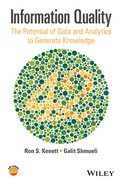Book Description
Provides an important framework for data analysts in assessing the quality of data and its potential to provide meaningful insights through analysis
Analytics and statistical analysis have become pervasive topics, mainly due to the growing availability of data and analytic tools. Technology, however, fails to deliver insights with added value if the quality of the information it generates is not assured. Information Quality (InfoQ) is a tool developed by the authors to assess the potential of a dataset to achieve a goal of interest, using data analysis. Whether the information quality of a dataset is sufficient is of practical importance at many stages of the data analytics journey, from the pre-data collection stage to the post-data collection and post-analysis stages. It is also critical to various stakeholders: data collection agencies, analysts, data scientists, and management.
This book:
- Explains how to integrate the notions of goal, data, analysis and utility that are the main building blocks of data analysis within any domain.
- Presents a framework for integrating domain knowledge with data analysis.
- Provides a combination of both methodological and practical aspects of data analysis.
- Discusses issues surrounding the implementation and integration of InfoQ in both academic programmes and business / industrial projects.
- Showcases numerous case studies in a variety of application areas such as education, healthcare, official statistics, risk management and marketing surveys.
- Presents a review of software tools from the InfoQ perspective along with example datasets on an accompanying website.
This book will be beneficial for researchers in academia and in industry, analysts, consultants, and agencies that collect and analyse data as well as undergraduate and postgraduate courses involving data analysis.
